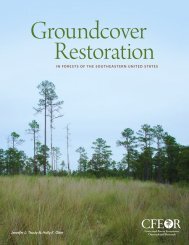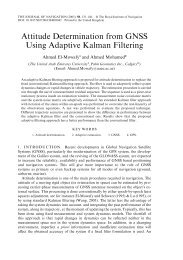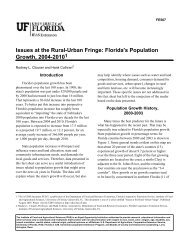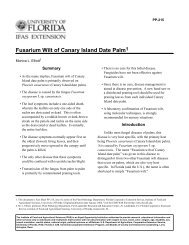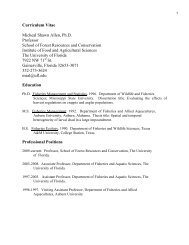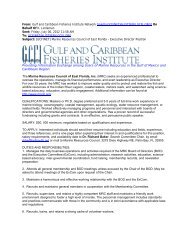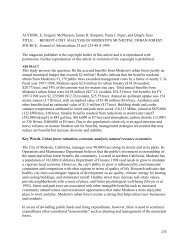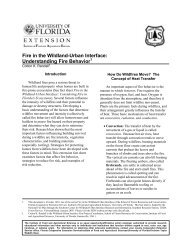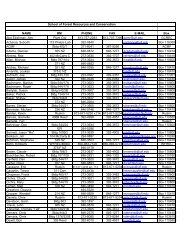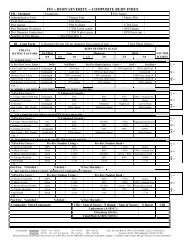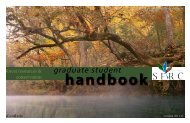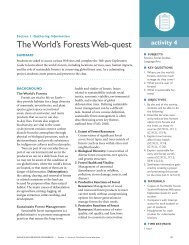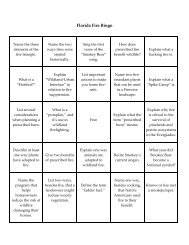Chapter 4: Plant Succession and Disturbances in the Urban Forest ...
Chapter 4: Plant Succession and Disturbances in the Urban Forest ...
Chapter 4: Plant Succession and Disturbances in the Urban Forest ...
You also want an ePaper? Increase the reach of your titles
YUMPU automatically turns print PDFs into web optimized ePapers that Google loves.
<strong>Chapter</strong> 4: <strong>Plant</strong> <strong>Succession</strong> <strong>and</strong> <strong>Disturbances</strong> <strong>in</strong> <strong>the</strong> <strong>Urban</strong> <strong>Forest</strong> Ecosystem 20<br />
example, conta<strong>in</strong>s prairies, savannas, woodl<strong>and</strong>s <strong>and</strong><br />
forests. The absence of fire has impacted <strong>the</strong>se<br />
ecosystems <strong>and</strong> <strong>the</strong>ir stages of succession <strong>in</strong> <strong>the</strong><br />
l<strong>and</strong>scape. Oak savannas have been almost totally<br />
excluded <strong>in</strong> <strong>the</strong> Chicago area <strong>and</strong> prairies have been<br />
<strong>in</strong>vaded by woody species. Historically, <strong>the</strong><br />
frequency <strong>and</strong> <strong>in</strong>tensity of fire determ<strong>in</strong>ed <strong>the</strong><br />
successional stage of <strong>the</strong>se ecosystems, that is,<br />
whe<strong>the</strong>r a given piece of l<strong>and</strong> would be an open<br />
grove or a dense forest (Figure 26). Restoration<br />
efforts <strong>in</strong> this case are based on re-<strong>in</strong>troduc<strong>in</strong>g fires.<br />
To date, fire has been re<strong>in</strong>troduced <strong>in</strong> several areas<br />
<strong>and</strong> native species typical of <strong>the</strong> region's ecosystems<br />
are be<strong>in</strong>g planted. In some areas, native trees have<br />
been cut to allow more light to reach <strong>the</strong> ground<br />
(Figure 27). Such practices allow <strong>the</strong> l<strong>and</strong>scape to<br />
support several stages of succession, rang<strong>in</strong>g from<br />
open prairies to forests.<br />
Figure 27.1 Photo courtesy of Chicago Wilderness<br />
Figure 27.2 Photo courtesy of Chicago Wilderness<br />
Figure 26. Historically, <strong>the</strong> frequency <strong>and</strong> <strong>in</strong>tensity of fire<br />
determ<strong>in</strong>ed <strong>the</strong> successional stage of ecosystems<br />
(whe<strong>the</strong>r a given piece of l<strong>and</strong> would be an open grove or<br />
a dense forest) <strong>in</strong> <strong>the</strong> Chicago area. Photo courtesy of<br />
Chicago Wilderness<br />
Some cont<strong>in</strong>uous or <strong>in</strong>termittent form of<br />
management may be needed to create disturbances <strong>in</strong><br />
situations where human activity has severely<br />
modified natural disturbances cycles. Efforts to<br />
restore historical flood<strong>in</strong>g cycles <strong>in</strong> <strong>the</strong> South Platte<br />
River watershed illustrate <strong>the</strong> need for an <strong>in</strong>tegrated<br />
restoration plan for a whole region. The floodpla<strong>in</strong>s<br />
along <strong>the</strong> South Platte river <strong>in</strong> Nebraska consist of a<br />
mosaic of different vegetation types. The presence of<br />
wooded or open vegetation was historically<br />
determ<strong>in</strong>ed by natural periodic floods. <strong>Forest</strong>s were<br />
conf<strong>in</strong>ed to drier sites, s<strong>in</strong>ce native woody species,<br />
such as willows (Salix spp.) <strong>and</strong> cottonwoods<br />
(Populus spp.), would not survive flood<strong>in</strong>g. Grasses,<br />
Figure 27. Due to suppression of fires, <strong>the</strong> once open<br />
savannas <strong>in</strong> <strong>the</strong> Chicago area (27.1) developed <strong>in</strong>to<br />
thickets of vegetation deprived of sunlight (27.2). Oak<br />
savannas began los<strong>in</strong>g <strong>the</strong>ir vast diversity of plants <strong>and</strong><br />
animals <strong>and</strong> were almost excluded from <strong>the</strong> l<strong>and</strong>scape.<br />
on <strong>the</strong> o<strong>the</strong>r h<strong>and</strong>, could tolerate flood<strong>in</strong>g, allow<strong>in</strong>g<br />
for open areas along <strong>the</strong> river.<br />
Channelization <strong>and</strong> upstream development<br />
reduced <strong>the</strong> water flow <strong>and</strong>, consequently altered<br />
flood<strong>in</strong>g periods. As a result, previously open areas<br />
of <strong>the</strong> floodpla<strong>in</strong> are nowdrier <strong>and</strong> <strong>in</strong>vaded with<br />
adjacent native forest species. Before channelization<br />
<strong>and</strong> development, migratory birds, such as <strong>the</strong><br />
endangered whoop<strong>in</strong>g crane (Grus americana) <strong>and</strong><br />
<strong>the</strong> s<strong>and</strong>hill crane (Grus canadensis) (Figure 28),<br />
used <strong>the</strong> open grassy floodpla<strong>in</strong>s for feed<strong>in</strong>g <strong>and</strong><br />
avoided roost<strong>in</strong>g <strong>in</strong> areas with abundant woody<br />
species. Because of <strong>the</strong>se changes <strong>in</strong> natural



